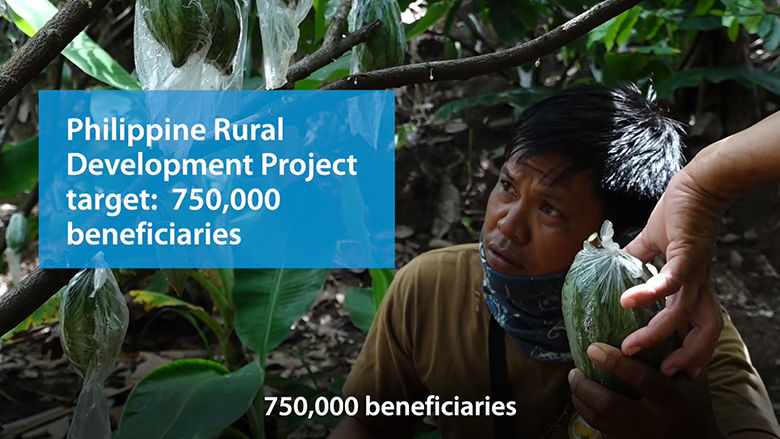Challenge
The agriculture sector contributes roughly 9 percent of the country’s GDP and continuously provides jobs to close to a quarter of working Filipinos. For many years, rural dwellers suffered from low incomes and limited opportunities for gainful employment. Many are poor and uncompetitive, due to constraints brought about by insufficient production inputs, lack of farm machineries and equipment, limited access to credit, and poor access to market, among others. Destructive weather events are also a major concern, disproportionately affecting the poor and the most vulnerable, many of whom reside in rural areas. The COVID-19 pandemic likewise increased unemployment including among those in the countryside.
Approach
PRDP is part of the Philippines’ Department of Agriculture’s (DA) efforts to improve the productivity of small farmers and fisherfolk and improve their access to markets. The project provides technical and funding assistance to local government units and producer groups or organizations to: (a) improve their agriculture commodity and investment planning and prioritization; (b) support the development and implementation agriculture-related infrastructure investments and agri-enterprise development subprojects; and (c) strengthen conservation and protection of selected critical coastal and marine protected areas. It also uses tools such as geotagging, value chain analysis and expanded vulnerability and suitability assessments to help guide public investments toward a modern, value-chain oriented, and climate-resilient agriculture and fisheries sector.
In response to the challenges due to COVID-19 lock down/enhanced community quarantine that started in March 2020, the project helped contribute to the restoration of food supply chains by mobilizing the assets and resources of the beneficiary-producer groups. The project also strengthened capacity and linked beneficiary-producer groups to e-commerce and online platforms which facilitated transportation and delivery of agricultural commodities to the markets. A Second Additional Financing is being proposed and has been retrofitted to support the Government’s economic recovery response to COVID-19 that focuses on food security.
Results
Started in 2015, the project has achieved the following major accomplishments:
- Provided agricultural assets and/or services to about 372,000 farmer and fisherfolk beneficiaries, 46 percent of whom are female beneficiaries. An additional 378,00 are and will be benefitting of ongoing and pipeline subprojects.
- Constructed/rehabilitated over 1,000 kilometers of farm-to-market roads (and another 1,100 kilometers are underway). These resulted in reduction of travel time by 33 percent and reduction in transport costs by 22 percent.
- Provided potable water to some 6,600 households. Another 15,700 households will benefit once the remaining potable water supply systems are completed.
- Provided technical and funding assistance to some 66,100 beneficiaries of agri-enterprises. These resulted to an average of 113 percent increase in real household income.
- Improved technical capacity of 81 Provincial Local Government Units (PLGUs) to plan and manage subprojects for developing the agriculture sector. All the PLGUs now have Provincial Commodity Investment Plans (PCIPs) which served as the basis in prioritizing agricultural commodities and investments funded under the project. In addition, the PCIPs mobilized and leveraged additional resources and funding from other stakeholders and sources estimated at US$1.22 billion.
- Increased management effectiveness of LGUs with all the 33 important marine sites having a Management Effectiveness Tracking Tool (METT) score of 66 or above (132% of target) and 23 have a Management Effectiveness Assessment Tool (MEAT) score of 66 or above (100% of target).
- Developed and implemented tools and innovations (e.g., geo-tagging, satellite overlays, and better information systems) as part of the project’s governance and institutional reform initiatives. These have saved some US$50 million through early cancellation or redesign of overlapping and/or duplicate infrastructure subprojects.
Bank Group Contribution
In 2014, IBRD approved a US$508.25 million loan, including a US$7 million grant from the Global Environment Facility (GEF) for strengthening conservation and protection of selected coastal and marine protected areas. In 2018, IBRD approved the First Additional Financing of US$170 million. Currently, a Second Additional Financing of US$280 million is being processed to support the Government’s economic recovery and food security response to COVID-19. The EU will co-finance this amount with a grant of Euro 20 million for priority areas in Mindanao.
Partners
The Philippines’ Department of Agriculture (DA) is the implementing agency for the project. DA works in partnership with Local Government Units (LGUs) at the provincial, city and municipal level. The DA through their regional field offices provide technical and financial support to LGUs and collaborate with them on the planning, design, implementation and supervision of priority subprojects, which are also co-financed by LGUs. This approach allows for an integration of local priorities into national development programs, making both effective partners in the development of the sector.
Moving Forward
The PRDP tools, approaches and strategies are being mainstreamed and integrated in the regular (locally funded) programs and activities of DA. The Value Chain Analysis and PCIPs have been used in updating the Regional Agriculture Fisheries and Modernization Plans as well as in the regular programs’ planning, budgeting and monitoring and evaluation activities. Infrastructure subproject engineering and design parameters are likewise now used as guide for locally funded subprojects. Some safeguards guidelines have also been introduced for consideration in the review and implementation of other projects and programs.


